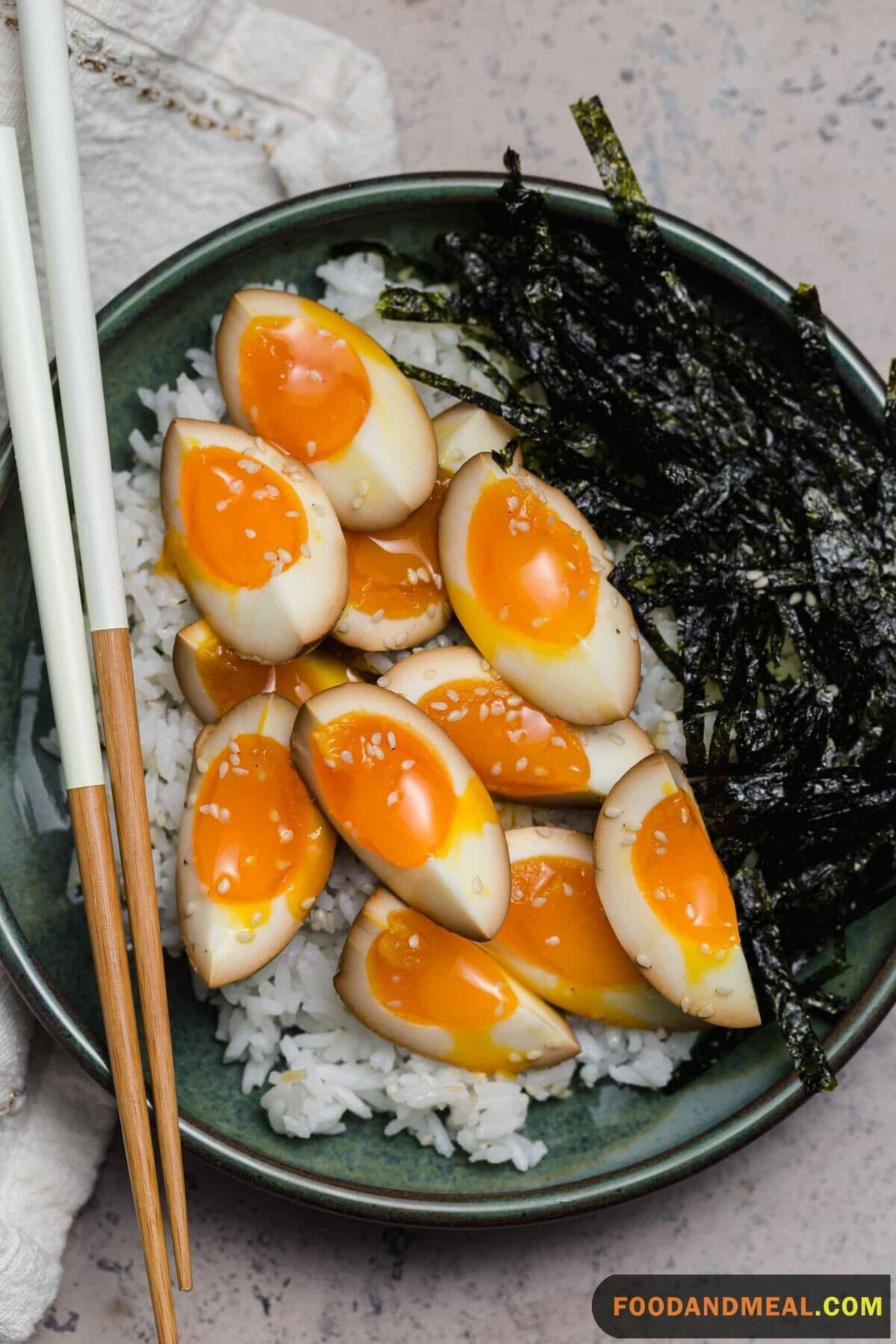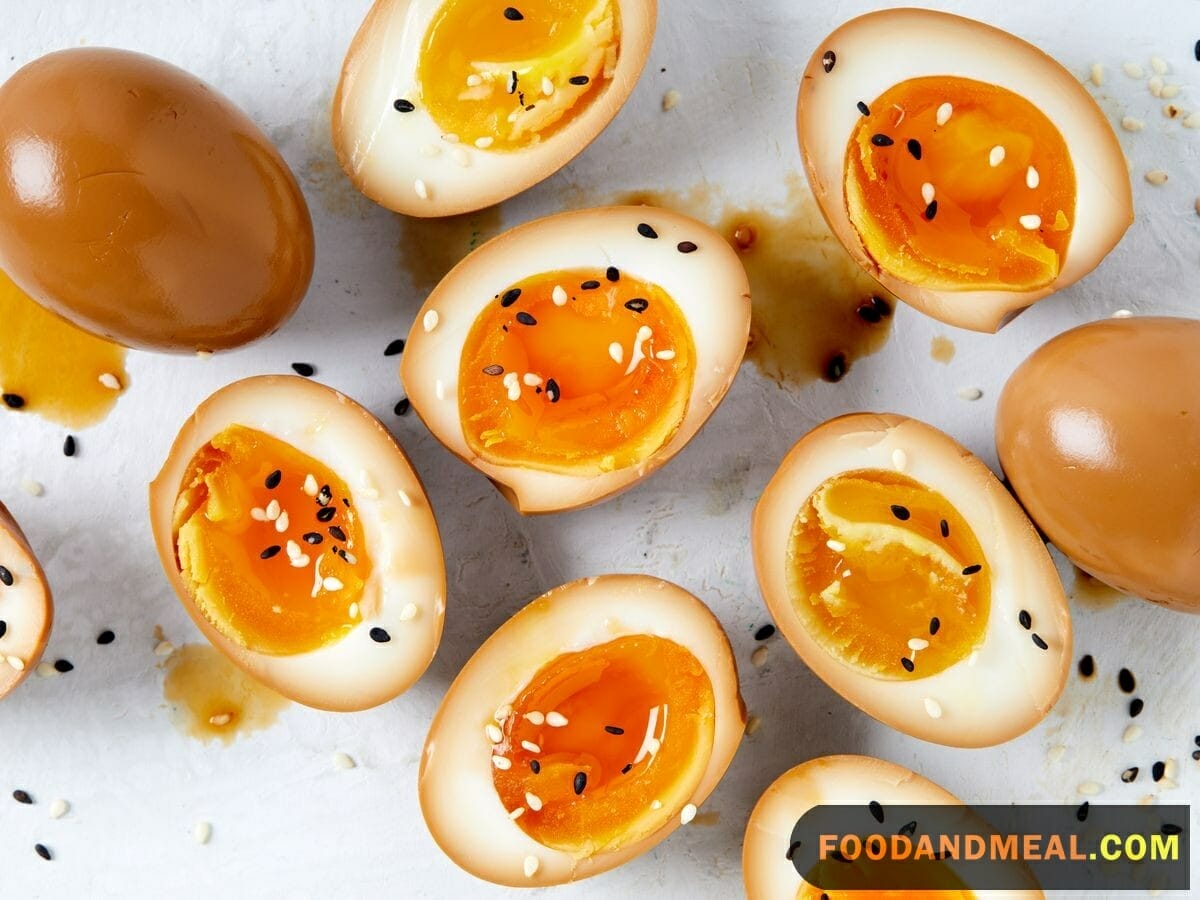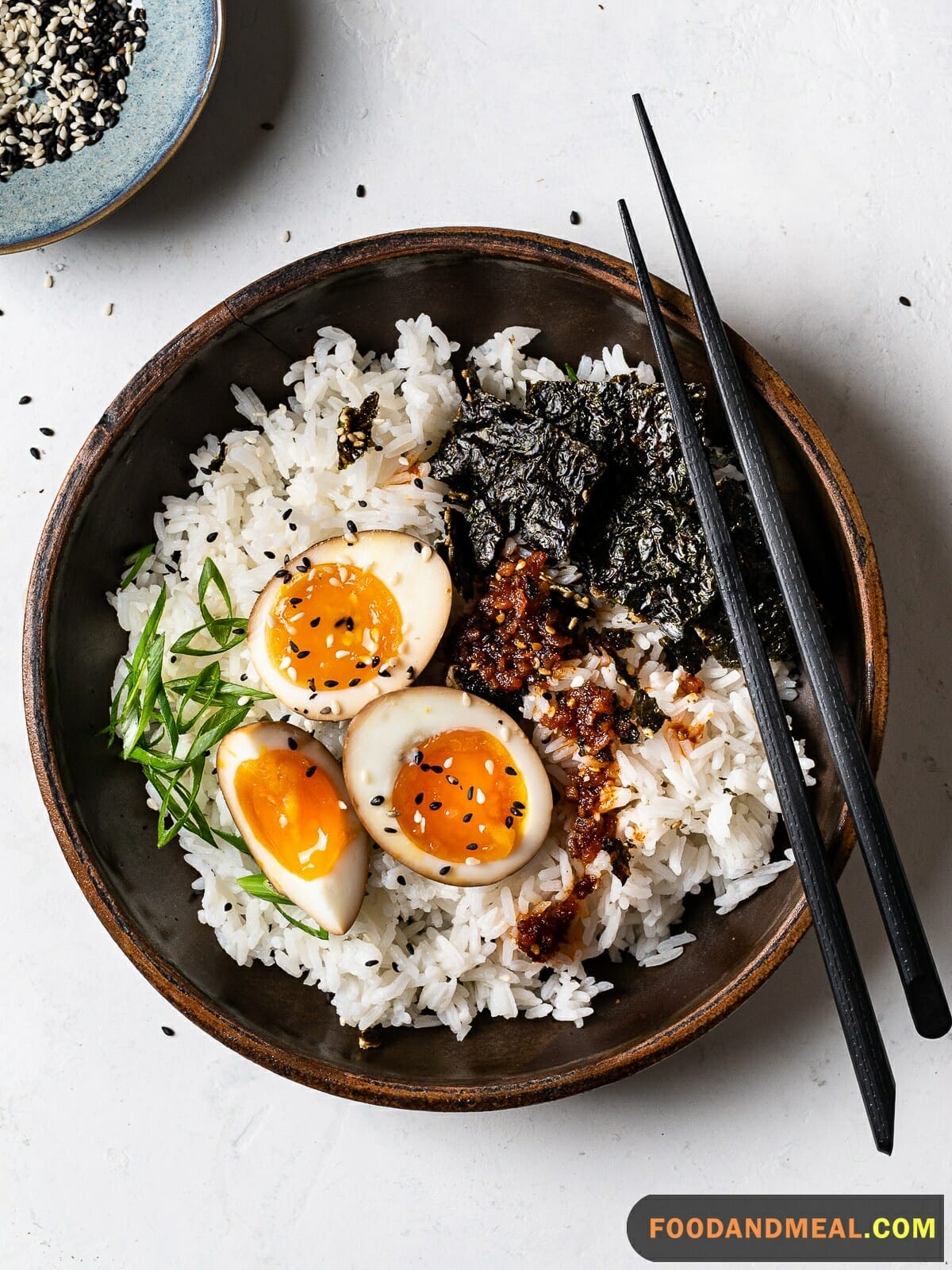Tracy Hilton here from Food and Meal, excited to share with you one of my favorite Japanese condiments – the versatile Soy Sauce Eggs!
Growing up, my family hosted lots of exchange students from Japan. I have such fond memories of all the new flavors they introduced me to, including these soy sauce eggs. The rich, salty umami flavor coating the tender boiled eggs was unlike anything I’d tried before. I was immediately hooked!
Now as an adult cooking for my own family, I rely on soy sauce eggs to add a punch of flavor to meals quickly. Keeping a batch of them ready in the fridge is one of my secret weapons for easy weeknight dinners! A few slices of soy sauce egg over hot rice and veggies makes the perfect simple meal.
The great thing about soy sauce eggs is how customizable they are to suit your tastes. You can play with the soy sauce to mirin ratio, adding more sweetness or saltiness. Spice it up with a dash of chili oil or some grated ginger. Fancy them up by adding tea, sake, or dashi to the marinade. The possibilities are endless!
Japanese Soy Sauce Eggs recipes


Soy Sauce Eggs
Equipment
Ingredients
- ¾ cup shoyu or low-sodium soy sauce
- ½ cup sake
- ¼ cup mirin
- ¾ cup warm water
- 1 tablespoon sugar
- 2 teaspoons ginger chopped fresh
- 6 Soft-Boiled Eggs chilled and peeled
Instructions
- In a saucepan, combine the shoyu, sake, mirin, water, sugar, and ginger. Bring to a boil over high heat, then reduce to medium-low and simmer, stirring frequently, until the sugar is completely dissolved, about 3 to 4 minutes. Transfer to a jar or container large enough to fit both the eggs and the liquid, and let cool.
- Add the peeled eggs to the cooled shoyu mixture and let marinate in the refrigerator for 8 to 10 hours (no longer than 12 hours or the eggs will become rubbery). Remove the eggs from the marinade and keep them in a bowl or jar, covered, in the refrigerator until ready to use. The eggs will keep in the refrigerator for up to 3 days.
- To serve, slice the eggs in half lengthwise and float 1 or 2 halves on top of a bowl of ramen.
Video
Notes
Nutrition
© Food And Meal
This website provides approximate nutrition information for convenience and as a courtesy only. Nutrition data is gathered primarily from the Spoonacular Database, whenever available, or otherwise other online calculators.
Alternative Method: Slow Cooker Soy Sauce Eggs

To prepare flavorful slow cooker Soy Sauce Eggs, start by ensuring your slow cooker is clean and optionally lined for easy cleanup. Boil the eggs until hard-boiled, then transfer them to an ice water bath to cool, cracking the shells slightly without peeling. In a separate bowl, mix soy sauce, water, mirin, garlic, ginger, cinnamon, star anise, sugar, peppercorns, and red pepper flakes for the marinade. Place the cracked eggs in the slow cooker and pour the marinade over them, ensuring they’re fully submerged. Cook on low for 4-5 hours to allow gradual flavor absorption. Check for doneness by peeling one egg after the cooking time, adjusting as needed. Once ready, cool the eggs and optionally garnish with green onions and sesame seeds before serving whole or sliced. These eggs are a delicious snack or appetizer, boasting deep, savory flavors thanks to the slow cooking process.
Tips for making Soy Sauce Eggs

Cooking Tips
First up, choose a good quality soy sauce. I prefer a Japanese brand like Kikkoman or Yamasa since they tend to be more aromatic and complex compared to Chinese varieties. The deeper color also helps the beautiful mahogany stain permeate the eggs. You’ll only need about 1 cup for a dozen eggs, so don’t be afraid to splurge a little here!
When it comes to the eggs, older ones with thicker shells and membranes work best since the soy sauce can penetrate deeper over several days of marinating. Gently crack each raw egg all over before adding to the soy sauce mixture to allow more surface area for that gorgeous color and flavor to seep in.
Now comes my favorite part – the aromatics! This is where you can really customize the flavor profile to suit your tastes. I like to add smashed garlic cloves, thin slices of ginger, a dash of rice wine, and a few strips of orange peel. Feel free to play around and make it your own!
As the eggs marinate for 3-5 days, gently turn them over every so often so the rich soy sauce penetrates evenly. Once they’re ready, the difference from plain hard boiled eggs is incredible! The whites turn a deep amber color and the golden yolks become even richer.
Serving Suggestions

For a delightful pairing with the savory Japanese Soy Sauce Eggs, consider serving them alongside a bowl of comforting Yakimiso Ramen. The rich and flavorful broth of the ramen will complement the umami taste of the eggs perfectly, creating a satisfying and hearty meal. Alternatively, you can enjoy the Soy Sauce Eggs as a topping for Sui-Gyoza Soup, adding an extra layer of flavor and texture to the comforting broth and dumplings. Whichever option you choose, these serving suggestions will enhance your dining experience with the delicious taste of Japanese cuisine.
Frequently Asked Questions about Soy Sauce Eggs

- How long can I store leftover Soy Sauce Eggs? Leftover Soy Sauce Eggs can be stored in the refrigerator for up to three days. Keep them in an airtight container, and if possible, store them in the remaining marinade to maintain their flavor.
- Can I reuse the marinade for a new batch of eggs? It’s generally safe to reuse the marinade for a new batch of eggs, but be sure to bring it to a boil before using it again to kill any potential bacteria from the previous batch.
- Q3: Can I use low-sodium soy sauce for a healthier option? Yes, you can use low-sodium soy sauce if you’re watching your sodium intake. It will result in a milder flavor, so you may need to adjust the seasoning accordingly.
- Can I freeze Soy Sauce Eggs? Freezing Soy Sauce Eggs is not recommended as it can negatively affect their texture and flavor.
- Can I make Soy Sauce Eggs with quail eggs for bite-sized servings? Absolutely! Quail eggs work wonderfully for bite-sized servings and are often used in Asian cuisine for this purpose. Adjust the cooking time accordingly as quail eggs cook faster than chicken eggs.
Conclusion
I hope you’ve enjoyed this little foray into classic Japanese comfort foods as much as I have. There’s just something so warm, nostalgic and satisfying about infusing eggs with rich, salty umami flavor.
If you give these Soy Sauce Eggs a try, I’d love to hear how they turn out! Post a photo on Instagram and tag @foodandmeal so I can see your delicious creations. Did you try adding any extra aromatics to the marinade? What dishes did you enjoy them with? I’m always looking for new ways to savor this versatile ingredient.
And be sure to keep checking the Food and Meal blog for more Japanese-inspired recipes to expand your culinary horizons. The intricate, complex flavors never cease to amaze me. I’ll be sharing my favorite ramen hacks, bento box building ideas, sushi rolling tips and so much more. There’s a whole world of delicious new tastes to experience!
Thanks for cooking along with me today! Here’s to many more happy days in the kitchen discovering new favorite flavors from around the globe. It’s through food that we can truly connect on a human level, even across oceans. So let’s eat, cook, and explore – one recipe at a time!
I'm Tracy F Hilton, a devoted culinary professional shaped by a mix of natural aptitude and refined skills from a top culinary school. In the dynamic kitchen environment, I'm a catalyst for seamless operations and timely, high-quality dish preparation. My culinary creations are a blend of art and skill, offering visually and gustatorily delightful experiences. A learner at heart, I'm continuously honing my craft, embracing new techniques, and culinary innovations. My positive, collaborative nature is amplified in fast-paced settings, showcasing my commitment to team efficiency and guest satisfaction. Each dish I present is a meticulous blend of tradition and innovation, promising an unforgettable dining experience that marries taste, aroma, and aesthetic appeal in perfect harmony. Join me on a gastronomic journey where each bite encapsulates a rich, evolving narrative of flavors and culinary artistry.





